The barn owl is a well-known bird. In fact, out of every bird species, the barn owl is the most widespread of them all. It can be found in just about every place except for desert and polar regions, the majority of Indonesia, parts of the Pacific islands, and north of the Himalayas in Asia.
Another name for this bird species is the common barn owl. They gave it this name to help differentiate it from varying species within its family.
And that’s just the tip of the iceberg.
Today, we’ll learn much more about this owl and other interesting facts and identifying features of these birds. The discussion will include the following topics:
- Identifying characteristics of a barn owl
- most common places to find them
- migratory patterns
- nesting habits
- behaviors
- and much more
Care to learn more about this magnificent creature? Read on to discover everything you ever needed to know about the barn owl and more.
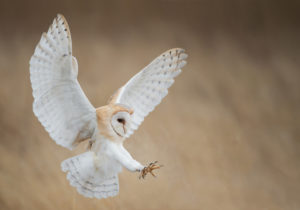
Barn Owl Bird Facts
- Common Name: Barn Owl
- Scientific Name: Tylo alba
- Scientific Family: Tytonidae
- Life Span: 4 years
- Size: 13.0 to 15.0 inches
- Wingspan: 31.0 to 37.0 inches
- Weight: 14.1 to 24.7 oz
- Conservation status: Least Concern
How To Identify A Barn Owl
To identify this owl, please note that it has a pale-colored body that’s typically medium-sized. It has long wings as well, but its tail is squarish and on the short side.
Across varying subspecies of barn owls, this bird has considerable size differences. On average, a typical barn owl is usually 13 to 15 inches in length with 31 to 37 inches in wingspan.
For the most part, when this owl lives on a small island, it’s usually lighter and smaller than typical owls. It also has dangling feathered legs and it follows an undulating flight pattern, which are very distinguishing features of the barn owl.
Combine this with its paleface and black heart-shaped eyes, which give this unusual yet attractive bird a very distinctive appearance. Some consider the face of this owl to look like a flat mask containing oblique and oversized black eye slits.
Related article: 10 Best Live Owl Cams Online: 24/7 Live Streaming
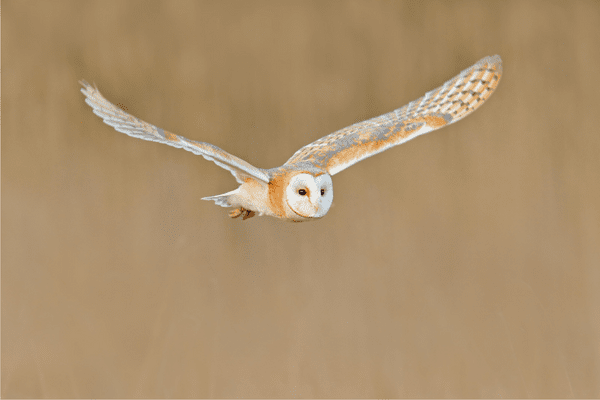
Differences Between Male & Female
The female of the species typically has gray features that are on the slightly darker side combined with rich brown coloring.
Male owls of this species, on the other hand, typically have light gray features that are typically mixed with light buff or white feathers.
Lastly, if there isn’t any barring on the tail, this certainly means that the owl is male.
Differences In Summer Plumage vs Winter Plumage
This bird has very soft plumage but it tends to remain the same during summer or winter seasons, so there aren’t any changes to mention.
Where You’ll See A Barn Owl
These owls are the most widespread bird out of every potential species. In fact, many consider it one of the most multicultural birds of all time.
With that said, these birds are found regularly in Australia, Southeast Asia, Europe, Africa, South America, North America, and India.
The only continent that isn’t known as a home to these creatures is Antarctica. Although, you have a difficult time seeing them because it’s rare since they tend to function at night in the dark.
These birds have a very distinct call as well. But it’s something that you’ll hardly ever hear out in the wild. It is possible to see or hear them in captivity, but that’s usually the extent of it.
Related article: 7 Simple & Proven Ways To Attract Owls To Your Yard
Barn Owl Migration Patterns
This owl is a non-migratory bird. It’s also the kind of bird that is found in many different areas throughout the world. In North America, you’ll find a plentiful supply of these nocturnal birds in southern New England, Michigan, North Dakota, and British Columbia. They also spend their lives in South America as well.
Besides the Americas, they are found in Asia, Australia, Africa, and Europe.
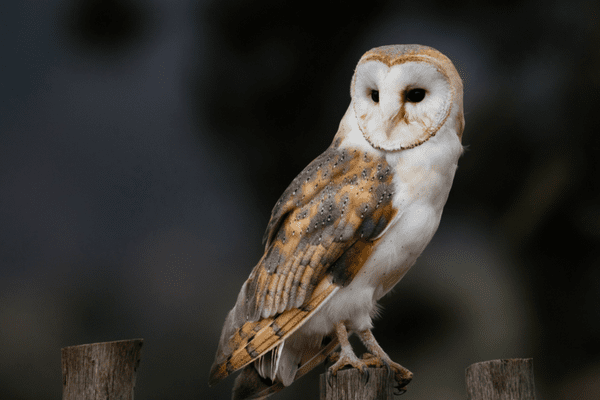
Diet and Feeding Preferences
As a nocturnal hunter, this owl is known for eating small mammals that it can easily find in the heat of the night. It regularly eats rats, voles, shrews, and mice. It’s also known as a creature that will consume the flesh of other birds.
They maintain a very keen sense of smell. This ability combined with its ability to see in low light makes it very capable of catching tiny prey. Plus, they are known for having very soft feathers. This light plumage makes it easy for these sneaky creatures to silently get behind pray without them knowing they are even being stalked.
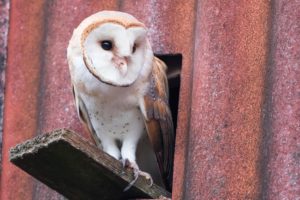
Barn Owl Nesting Facts
- Clutch Size: 5-7 eggs
- # of Broods: 1 brood
- Incubation Period: 29-34 days
- Nestling Period: 55-70 days
- Egg Description: Dull White
As far as investing is concerned, this bird will nest in nest boxes, buildings, cliff cavities, and hollow trees. Unlike many other species, this owl will not typically tend to build a true nest. They usually find a bunch of debris around their nesting area and form it into a depression.
While nesting, the female barn owl can lay anywhere from 2-11 eggs at the least or most. But on average, the female is known to lay roughly 5-7 eggs per incubation mating session. After the female lays her eggs, she will typically incubate them for 29-34 days.
On average, young owls begin flying after being born for 60 days. After making their first flight, young owls of this species tend to return to the nest for a few weeks before leaving the nest entirely.
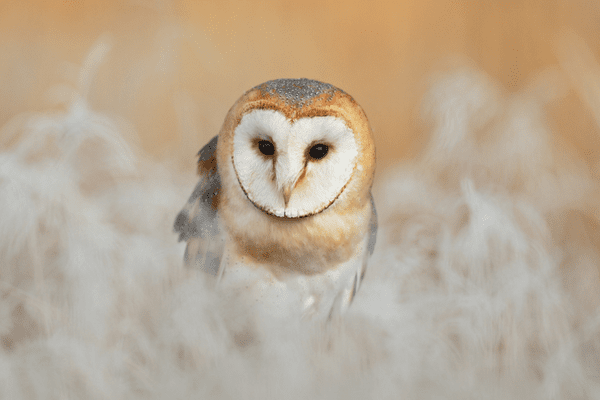
Barn Owl Behavior
In the case of this owl being threatened, it initiates a very specific wing spreading and swaying behavior. The bird will spread its wings as wide as possible while swaying its head moving it back and forth. Even more interesting, this nocturnal creature will occasionally fall onto its back and kick with its feet toward the potential threat in an effort to protect itself.
These creatures also have the ability to locate prey at night very easily using sight and sound. Their phenomenal low light vision makes it easy to spot prey in the middle of the night, which isn’t always possible for other bird species. They also have incredible hearing, which makes it simple to locate different types of prey by sound, which helps keep these birds safe and well-fed.
Related article: Owl Life Expectancy: How Long Do They Live?
Tips for Birdwatchers On How To Attract A Barn Owl
Since these owls are pretty much everywhere besides really hot or really cold climates, it’s pretty easy to attract them to your home. Although they only come out at night, it isn’t always easy to see them.
One of the best methods for attracting these creatures is to install nesting boxes throughout your backyard. Make sure it’s set up in a secure location throughout your home. Many owls like to sleep in hollow cavities within trees, but other owl species including barn owls actually like to spend time in manufactured nesting boxes.
When installing a nesting box, make sure to place it 10-12 feet off the ground. Keep it in an area where they’ll have no problem hunting for small animals including rats, mice, voles, and shrews.
Instead of pruning large tree branches, keep them intact. The owls like to perch on them at night, which creates a beautiful opportunity for you to see them in their natural habitat.
Create a more appealing hunting ground by mowing the lawn less. Provide birdbaths because these owls tend to drink and bathe in large baths, and leave the flood lights on timers. A well-lit backyard isn’t going to be appealing to night stalking owls of this kind.
Conservation Status
This owl has a conservation status that is considered Least Concern. According to Wikipedia, this means, “A Least Concern species is a species that has been categorized by the International Union for Conservation of Nature (IUCN) as evaluated as not being a focus of species conservation because the specific species is still plentiful in the wild.”
Fun & Interesting Facts
- This owl has soft fringe-edged feathers. They are considered silent feathers and they do not make a swishing sound as the bird moves through the air.
- These creatures are relatively small in body size. They are typically around the size of a smaller cat, yet they only weigh about a pound.
- They have tremendous hearing and night vision. This makes it easy for them to capture prey in the dark of night.
- They are known for making screeching and hissing noises. These noises are eerie and kind of scary when you hear them at night.
- These owls have incredibly short lifespans. Roughly 70% of these creatures die within their first year of life.
- They have incredibly voracious appetites. They can eat more than their entire weight in rats and mice in one evening.
- These birds like to live in man-made structures including church towels, barns, water tanks, and silos.
Explore More Species in This Family
- North American Barn Owl
- Central American Barn Owl
- Bahamian Barn Owl
- Cuban Barn Owl
- Subandean Barn Owl
- Colombian Barn Owl
- Hellmayr’s Barn Owl
- Brazilian Barn Owl
- Tortugan Barn Owl
- Dominican Barn Owl
- St. Lucia Barn Owl
- Curaçao Barn Owl
- Galapagos Barn Owl
- British Barn Owl
- European Barn Owl
- Madeiran Barn Owl
- Ernest’s Barn Owl
- Canary Island Barn Owl
- Cape Verde Barn Owl
- West African Barn Owl
- SAO Thome Barn Owl
- African Barn Owl
- Madagascan Barn Owl
- Erlanger’s Barn Owl
- Indian Barn Owl
- Burmese Barn Owl
- Andaman Barn Owl
- Sumban Barn Owl
- Kisar Barn Owl
- Savu Barn Owl
- New Guinea Barn Owl
- Boaing Island Barn Owl
- Santa Cruz Barn Owl
- New Caledonia Barn Owl
- Australian Barn Owl
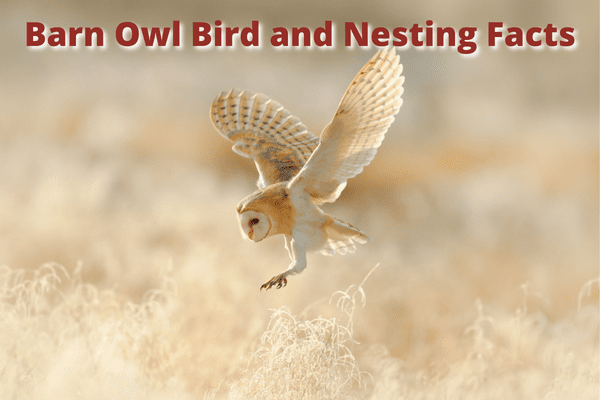
from BirdInformer.com https://ift.tt/7s10NJx

No comments:
Post a Comment